The Aztec Sun Stone, also commonly referred to as the Calendar Stone, is a remarkable monument that intricately reveals the Aztec worldview, encapsulating their complex mythology rather than functioning as a conventional timekeeping device. Crafted with extraordinary precision from solid basalt, this imposing stone—measuring roughly 3.6 meters across, nearly a meter thick, and weighing an astonishing 25 tons—embodies Aztec beliefs regarding cosmic cycles, divine authority, and the fragility of existence itself.
Unearthed from beneath the bustling heart of Mexico City in December 1790, this stone originally adorned the sacred precinct of Templo Mayor, the spiritual epicenter of Aztec civilization. Its discovery, intriguingly upside-down, has sparked compelling speculation: was it intentionally concealed by Aztec priests to prevent the foretold apocalypse—the collapse of the Fifth Sun—during the devastating Spanish conquest?
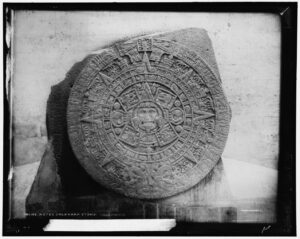
An Aztec calendar stone photographed by William Henry Jackson in Mexico City, 1884. Jackson was a renowned photographer of the American west.
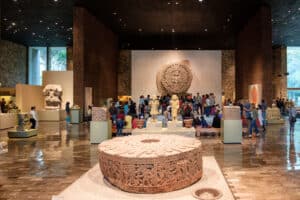
The Aztec Calendar or Stone of the Sun at the National Museum of Anthropology in Mexico City
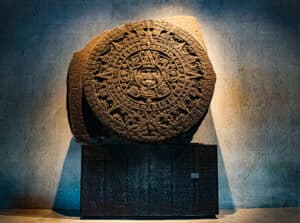
The Aztec Sun Stone, installed in the National Museum of Anthropology.
Dominating the stone’s core is an enigmatic visage, widely interpreted as Tonatiuh, the formidable Aztec Sun deity, though some scholars argue convincingly it could represent Tlaltecuhtli, the earth monster symbolizing cosmic catastrophe. With a protruding tongue sculpted into the form of a sharpened sacrificial blade, this figure evokes vivid imagery of human sacrifice, blood offerings, and divine nourishment—a stark reminder of the gods’ relentless demand for sustenance.
Surrounding this central iconography are four intricate glyphs, each marking previous cosmic epochs, known as “Suns”, whose destructions punctuated Aztec mythology. The legend narrates dramatic tales of rivalry between Quetzalcoatl and Tezcatlipoca, deities who vied fiercely for cosmic supremacy, resulting in successive eras of creation and annihilation. Starting from the upper-right quadrant, the stone portrays these eras vividly: Nahui Ocelotl (Four Jaguar), destroyed by beasts; Nahui Ehecatl (Four Wind), annihilated by fierce winds; Nahui Quiahuitl (Four Rain), devastated by fire and volcanic eruptions; and Nahui Atl (Four Water), swept away by devastating floods. Each glyph is carefully positioned, illustrating a cyclical narrative of rebirth and doom, crucial to Aztec cosmological understanding.

The Aztec Calendar or Stone of the Sun at the National Museum of Anthropology in Mexico City
Encircling this dramatic tableau is an elegant band bearing the 20-day names of the Aztec calendar, which, though not indicating practical calendrical functions, reinforce its symbolic purpose: the intertwining of divine order and temporal cycles. This circle is further embraced by another decorative ring, intricately carved with symbols reminiscent of turquoise and jade—precious stones associated with the heavens and celestial cycles, particularly the equinoxes and solstices, fundamental in Aztec religious practices.
Moreover, at the base of the stone, two imposing fire serpents emerge, their sinuous forms elegantly enveloping the stone’s perimeter, tails meeting heads in perpetual motion, symbolizing eternal cosmic continuity. These serpentine figures, beyond their aesthetic appeal, suggest the unending cyclical nature of the Aztec universe.
Two formidable jaguar figures, depicted with claws firmly gripping human hearts, frame the central deity, powerfully symbolizing earthly dominion and the vital role of sacrifice in maintaining cosmic harmony. These jaguar motifs underscore the intimate connection between earthly rulership and celestial legitimacy, a bond explicitly represented by a date glyph atop the stone: “13 Reed.” Far from a random marking, this glyph references the historical ascension of the ruler Itzcoatl in 1427 CE, thereby strategically linking terrestrial authority directly to divine approval.
This extraordinary artifact, now prominently displayed at the National Museum of Anthropology in Mexico City, continues to captivate visitors and scholars alike. But perhaps its greatest legacy is the profound questions it invites: How did the Aztecs envisage the inevitable collapse of their world? Clearly, the Aztec Sun Stone transcends mere historical artifact status, serving instead as a mesmerizing reflection on humanity’s perpetual confrontation with the cycles of creation and destruction.

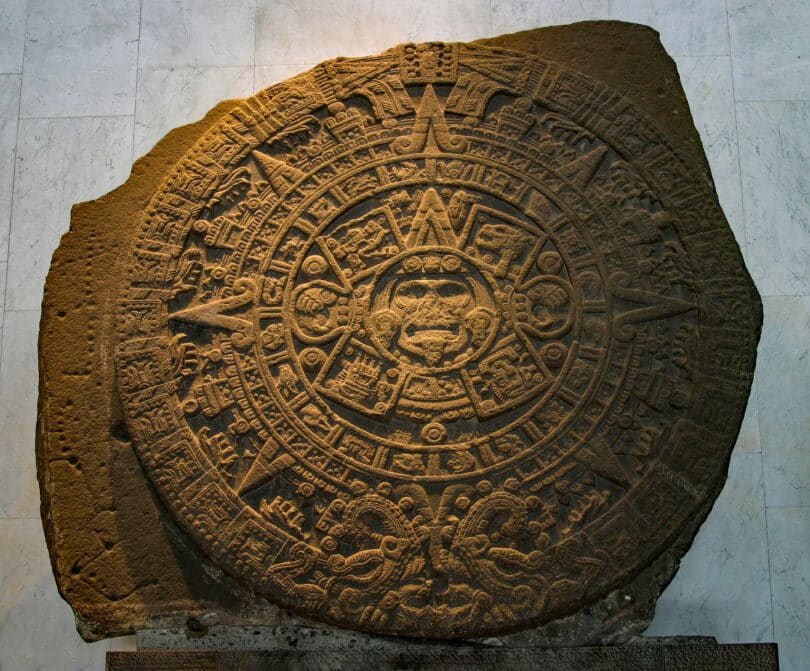
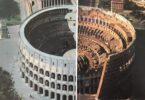
Leave a Comment
You must be logged in to post a comment.